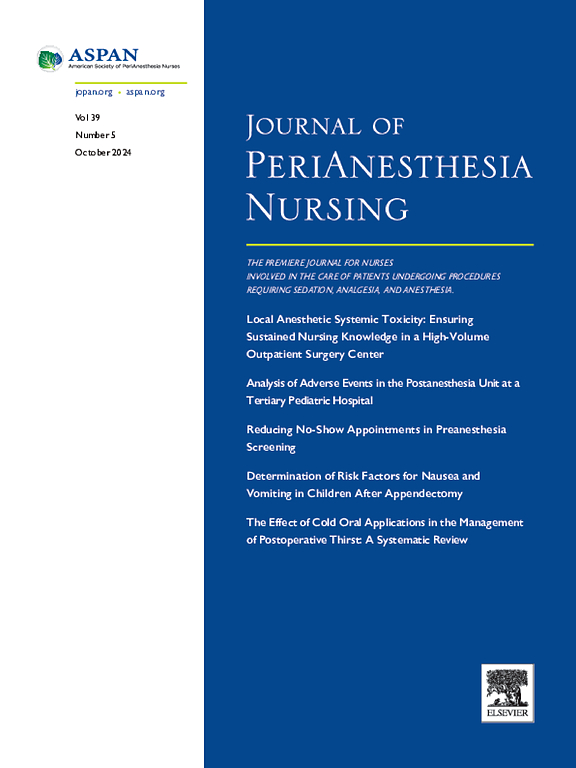Development of a Preoperative Screening Tool to Reduce Morbidity and Mortality of COVID-19-positive Hepatobiliary Patients
IF 1.6
4区 医学
Q2 NURSING
引用次数: 0
Abstract
Purpose
This study aimed to create a preoperative risk assessment form for COVID-19-positive hepatobiliary patients to guide further prevention of complications after surgery and reduce morbidity and mortality.
Design
Based on the literature, focus groups, and case studies, a multidisciplinary panel of 15 experts conducted three rounds of a Delphi study that resulted in the development of a preoperative risk assessment form to be used by healthcare professionals in the treatment of COVID-19-positive hepatobiliary patients.
Methods
A preoperative risk assessment form for health professionals to use among COVID-19-positive hepatobiliary patients was developed based on literature, focus groups, and case studies. A 3-round Delphi study was conducted to validate and revise the risk assessment form using a multidisciplinary panel of 15 experts involved in hepatobiliary surgery.
Findings
The experts demonstrated high cooperation and familiarity with the research topic, with positive coefficients ranging from 93.33% to 100% and authority coefficients ranging from 0.83 to 0.86. The coordination coefficients were 0.33, 0.26, and 0.22, respectively, indicating good coordination among expert opinions. The final risk assessment form included 9 primary (first-level) indicators, 38 secondary (second-level) indicators, and 122 tertiary (third-level) indicators.
Conclusions
The preoperative risk assessment form for hepatobiliary surgery patients infected with COVID-19 is scientifically rigorous, reliable, and valid. This screening tool may be used by health providers to identify high-risk patients, prevent postoperative complications, and reduce morbidity and mortality.
开发术前筛查工具,降低 COVID-19 阳性肝胆病患者的发病率和死亡率。
目的:本研究旨在为COVID-19阳性肝胆疾病患者制定一份术前风险评估表,以指导进一步预防术后并发症,降低发病率和死亡率:设计:根据文献、焦点小组和病例研究,一个由15名专家组成的多学科小组进行了三轮德尔菲研究,最终制定了一份术前风险评估表,供医护人员在治疗COVID-19阳性肝胆病患者时使用:方法:根据文献、焦点小组和病例研究,为医护人员制定了一份术前风险评估表,供COVID-19阳性肝胆病患使用。由 15 名肝胆外科专家组成的多学科小组进行了三轮德尔菲研究,以验证和修订风险评估表:专家们对研究课题表现出高度的合作和熟悉,积极系数从 93.33% 到 100% 不等,权威系数从 0.83 到 0.86 不等。协调系数分别为 0.33、0.26 和 0.22,表明专家意见之间协调良好。最终的风险评估表包括 9 个一级(一级)指标、38 个二级(二级)指标和 122 个三级(三级)指标:针对感染 COVID-19 的肝胆手术患者的术前风险评估表科学严谨、可靠有效。医疗服务提供者可利用该筛查工具识别高风险患者,预防术后并发症,降低发病率和死亡率。
本文章由计算机程序翻译,如有差异,请以英文原文为准。
求助全文
约1分钟内获得全文
求助全文
来源期刊

Journal of Perianesthesia Nursing
NURSING-
CiteScore
2.20
自引率
17.60%
发文量
279
审稿时长
90 days
期刊介绍:
The Journal of PeriAnesthesia Nursing provides original, peer-reviewed research for a primary audience that includes nurses in perianesthesia settings, including ambulatory surgery, preadmission testing, postanesthesia care (Phases I and II), extended observation, and pain management. The Journal provides a forum for sharing professional knowledge and experience relating to management, ethics, legislation, research, and other aspects of perianesthesia nursing.
 求助内容:
求助内容: 应助结果提醒方式:
应助结果提醒方式:


